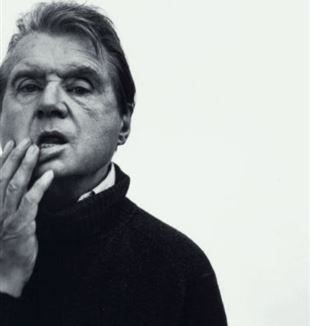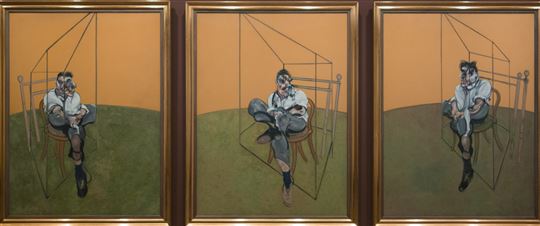
Francis Bacon: Appearance and the Mystery
One hundred years after his birth, we set out to discover the less explored side of a controversial artist. A man who always kept in sight in his studio, was a crucifix, because “I’ve found no other subject that so embraces all the areas of the human.”In his chaotic London studio, Irish-born Francis Bacon kept a reproduction of Cimabue’s Crucifixion, the one “wounded” in the 1966 flood in Florence. He had it hung upside down, as an unsubstitutable point of reference, not to be copied–this is why he kept it upside down–but from which he could always draw inspiration, a fixed point to look at before setting to work at his easel. When David Sylvester, his great friend and art critic, asked why he, so far from the Church and so against the moral code of Catholicism, kept that particular image hung in his studio, Bacon’s response was very simple: “To date, I have found no other subject that so embraces all the areas of human feeling and behavior.” Then, when the critic pressed, he explained the unique meaning the Crucifixion had for him, compared to all other subjects: “I realize that one works with one’s own sentiments and sensations. Before the Crucifixion, there come into the field all sorts of very personal sentiments on behavior and how life is.”
Francis Bacon is certainly one of the great artists of the 20th century. This year marks the centennial of his birth, which was commemorated by an exhibit at London’s Tate Gallery and then at the Prado in Madrid (the city where he died in 1992). The exhibit, “Francis Bacon: A Centenary Retrospective,” featuring 130 works, will be on display at the Metropolitan Museum of Art, May 20–August 16, 2009.
In addition to being one of the great artists of the century, Bacon was one of the most scandalous, for a variety of reasons. The obvious ones are his homosexuality and his corrosive vision of all traditional social institutions, but the less obvious ones include his implacable, obsessive attachment to figurative art, with its constant epicenter in the human body, and the profound, dramatic sense of mystery on which all his work insisted.
Bacon can be viewed with a squeamish eye or a moralistic eye. The squeamish eye is that of the bourgeois viewer who finds his intensely physical and violent painting to be repugnant. The moralistic one is that of the believer who, before the scandalousness of his work, censures, a priori, the questions or issues it raises.
No cheating. Reacting instinctively before Bacon’s work means liquidating it, even if rhetorically one speaks of him as a great artist. Instead, the more serious (and more exciting) thing to do would be to get the book of his collected interviews with David Sylvester. Extraordinary in its human intensity, it is one of the most striking documents on the condition of man and on the meaning of culture in our time.
What’s impressive in these dialogues is how Bacon always goes straight to the heart of the matter. He gets there by his own road, but with no easy outs, and no ambiguity. He explains that his sense of doing art is tied to man’s profound desire to grasp an order, “even though within this order there can be strongly instinctive and chance elements.” For this reason, art can’t settle for illustrating reality: “Isn’t it possible that one wants a thing to approach as much as possible the given reality and, at the same time, to be profoundly capable of suggesions and of unlocking areas of feeling, instead of limiting itself to a simple illustration of the object one intends to represent? Isn’t this, deep down, the meaning of art?”
In doing art, the space of mystery is a very large space. One paints but, in a certain sense, one “allows it to be done.” One has an idea, but the realization of this idea is something that goes beyond calculation. Doing art involves going out of oneself, entrusting oneself to something that, materialistically, and without cheating, Bacon called “chance.” He said, “For me, the mystery of painting today is the way of rendering the appearance. I know that it can be illustrated; I know it can be photographed. But how can it be rendered so as to capture its mystery within the mystery of its making?” That is, how can the artist capture the mystery that constitutes the forms on the plane of reality, within the mystery that he makes exist on the canvas? Only in this way does the painter achieve his task. It goes beyond the simple inert replication of things. “There are rules established on what is or should be the appearance, but there’s no doubt that the ways of rendering the appearance are many. From an accidental brushstroke, suddenly a vividness can gush out that is not achievable with any of the codified ways.”
Two faces. This is the risk that the artist has to accept: realism must be continually reinvented, as Van Gogh wrote in his letters. “This is the only way the painter can reproduce the intensity of reality he’s trying to capture. Van Gogh is one of my great heroes because I think he managed to restore, through the way he painted, a marvelous vision of reality.”
Speaking of vision of reality, why are his images so dramatically distorted? Why create forms that at times even seem repulsive? Bacon explained, “One distorts what one loves,” and flipped the question: “It’s very questionable to view as damage the distortions that to my mind at times project an image with greater power. I don’t believe it’s a matter of damage. One communicates the sensation and the sentiment of life in the only way one can. I’m not saying it’s a good way, but one communicates it in the most acute way possible.”
And anyway, he continued, art can’t censure the dimension of death, which is a constitutive part of every form and of every body. “I always have this sense of being mortal. One should be as aware of this as one is aware of life, like two faces of the same coin spinning between life and death. This idea is very present to me concerning people and also about myself. I’m always very surprised when I wake up in the morning.”